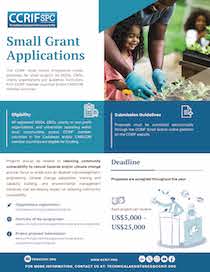Grand Cayman, Cayman Islands, October 30, 2017. CCRIF SPC (formerly the Caribbean Catastrophe Risk Insurance Facility) announced today that Trinidad & Tobago will receive a payout of US$7,007,886 (approximately TT$47.4 million) on its Excess Rainfall policy following a period of heavy rainfall between October 18 and October 20 2017. CCRIF was able to determine the value of the payout after the end of this rainfall event and the payout will be made to the Government within 14 days after the end of the event.
Trinidad & Tobago has been a member of CCRIF since 2007 and has purchased CCRIF policies for Tropical Cyclone and Earthquake since 2007. In recent years, Trinidad & Tobago has experienced severe hydrological events not associated with hurricanes, resulting in major flooding and loss of property and livelihoods. This year, for the first time, the Government purchased a CCRIF policy for Excess Rainfall (XSR) and has two separate XSR policies in place – one for Trinidad and one for Tobago. Following the recent heavy rainfall, the policy for Trinidad triggered.
CCRIF insurance products for earthquakes, tropical cyclones and excess rainfall are parametric and make payments based on the intensity of an event (for example, earthquake intensity, hurricane wind speed, volume of rainfall) and the amount of loss calculated in a pre-agreed model caused by these events. In the case of rainfall, losses are estimated using a model based on amount of rainfall (excess rainfall). Hazard levels are then applied to pre-defined government exposure to produce a loss estimate. Payout amounts increase with the level of modelled loss, up to a pre-defined coverage limit. Therefore payouts can be made very quickly after a hazard event – and in the case of CCRIF, within 14 days after the event. This is different from traditional insurance settlements that require an on-the-ground assessment of individual losses after an event before a payment can be made – a process that can often take months or even years.
Local officials and technocrats in Trinidad have referred to the recent rainfall, which has caused widespread flooding, as "unprecedented". The CCRIF payout will provide quick liquidity to the Government for immediate repairs and recovery efforts. Countries need to be mindful that CCRIF was not designed to cover all the losses on the ground – but rather to allow governments to reduce their budget volatility and to guarantee sufficient capital for emergency relief.
Providing quick liquidity to affected countries post disaster was the main rationale for the establishment of CCRIF in 2007.
The Caribbean is experiencing the effects of climate change with more frequent and extreme weather events such as hurricanes, rainfall events and drought. This is becoming the new normal. Analysis from an Economic of Climate Adaption (ECA) Study undertaken by CCRIF in 2012 showed that that annual expected losses from wind, storm surge and inland flooding already amounts to up to 6 per cent of GDP in some countries and that climate change could increase expected loss by 1 - 3 per cent of GDP by 2030.
This payout to the Government of Trinidad & Tobago brings the total CCRIF payouts in 2017 to approximately US$61.5 million, which includes US$30.8 million for Hurricane Irma and US$23.6 million for Hurricane Maria. Since the inception of the facility in 2007, CCRIF has made payouts totalling US$123.5 million to 12 member governments – all made within 14 days of the event. This payout to Trinidad will bring total payouts to US$130 million. These monies usually represent the first injection of liquidity to countries affected by catastrophe events. While CCRIF’s payouts are relatively small compared to the overwhelming cost of rebuilding, all recipient governments have expressed appreciation for the rapid infusion of liquidity, which they are able to use to address immediate priorities.
About CCRIF SPC: CCRIF SPC is a segregated portfolio company, owned, operated and registered in the Caribbean. It limits the financial impact of catastrophic hurricanes, earthquakes and excess rainfall events to Caribbean and – since 2015 – Central American governments by quickly providing short-term liquidity when a parametric insurance policy is triggered. It is the world’s first regional fund utilising parametric insurance, giving member governments the unique opportunity to purchase earthquake, hurricane and excess rainfall catastrophe coverage with lowest-possible pricing. CCRIF was developed under the technical leadership of the World Bank and with a grant from the Government of Japan. It was capitalized through contributions to a Multi-Donor Trust Fund (MDTF) by the Government of Canada, the European Union, the World Bank, the governments of the UK and France, the Caribbean Development Bank and the governments of Ireland and Bermuda, as well as through membership fees paid by participating governments. In 2014, an MDTF was established by the World Bank to support the development of CCRIF SPC’s new products for current and potential members, and facilitate the entry for Central American countries and additional Caribbean countries. The MDTF currently channels funds from various donors, including: Canada, through the Department of Foreign Affairs, Trade and Development; the United States, through the Department of the Treasury; the European Union, through the European Commission, and Germany, through the Federal Ministry for Economic Cooperation and Development.
CCRIF is celebrating its 10th anniversary this year – 2017.





